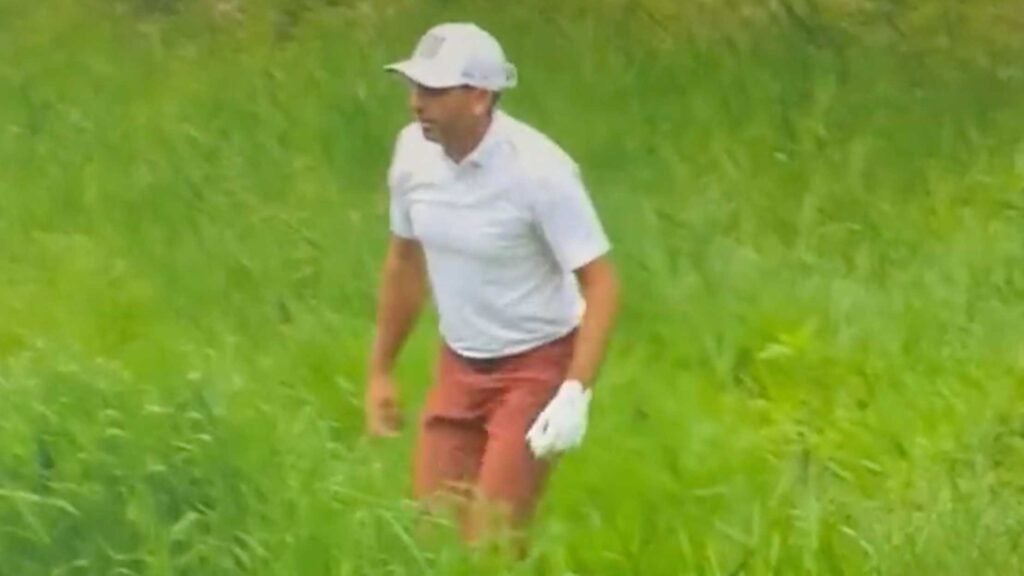He fussed. He fumed. He vented his frustration at a Tour referee and talked about taking his talents elsewhere.
In his heated response to a lost-ball ruling at last week’s Wells Fargo Championship, Sergio Garcia exercised his right to free speech.
But did he overlook a legal option that might have helped his cause?
In short: Did Garcia blow it by not invoking Rule 20.1(c) 3?
Before we get into the nitty gritty, let’s review the sequence of events. During Thursday’s opening round at TPC Potomac, Garcia tugged his tee shot on the par-5 10th hole into a red-staked area beyond a creek, and then began a process weekend duffers know too well: hunting in the thicket for his ball.
Eventually, he found it, but to no avail, as the referee ruled that the allotted three minutes for searching had expired.
Though Garcia disagreed, and vocally so, he accepted the decision, took a penalty drop, and played on. Only later did tournament officials determine that Garcia had been right; the referee had started the search clock too early. By that point, though, the penalty had to stick because there was no way of knowing what Garcia would have scored with his original ball.
Watching all of this transpire from home, the rules-savvy fan might have wondered: Wait, if Sergio was convinced that the ref had it wrong, why didn’t he play two balls — his original ball and the penalty ball?
Under Rule 20.1 (c) 3, that would have been allowed.
The rule, which applies in stroke play but not in match play, is meant to ensure that everyone gets a fair shake — the golfer and the rest of the field.
Maybe you have even leaned on it yourself when you and your playing partners have come to loggerheads at your local club. Unable to resolve your disagreement in the moment, you play two balls to cover your bases, record both scores and leave it to your head pro to sort things out.
Tour pros can do pretty much the same.
Rather than simply take a penalty drop, Garcia could have asked to play two balls, and the referee almost certainly would have allowed it, said Steve Rintoul, the Tour’s senior tournament director.
“There’s not a professional referee in the world who is not going to let him do that,” Rintoul said. “You’re protecting the player’s rights, and you’re protecting the field.”
Under the rule, a couple of conditions would have applied: Garcia would have had to announce that he was going to play two balls before hitting either; he also would have had to declare which of those balls he wanted to count. If he failed to make that declaration, then the first ball he struck would have counted by default.
Got it?
If you’ve never seen a Tour pro play two balls in competition, you’re not alone. It doesn’t happen often. With so many eyeballs on the action, and so many cameras on hand for video review, lingering disagreements are exceedingly rare. A decision gets made. The player moves on.
But that’s not to say it never occurs. During last year’s FedEx Cup Playoffs, at the Northern Trust, for example, Scottie Scheffler played two balls on a hole after he and his playing partners couldn’t agree on whether Scheffler had found an errant shot within the allotted time. Scheffler thought he had, his partners thought he hadn’t. (When subsequent video review of the matter proved inconclusive, Scheffler made things easy on everyone and accepted the penalty.)
The point of Rule 20.1(c)3 is to protect a player against an unwarranted penalty — but not to ensure that a player gets a lower score.
Which brings us back to Garcia. After taking his drop on the 10th, Sergio went on to make par, which was a good score, all things considered. Had he played two balls, he could have hacked out his original ball from the long grass and gotten up-and-down for a birdie 4. He also could have wound up with a bogey, a double. Or worse.
In that case, his grumbling almost surely would have continued. But he would have had no one to blame but himself.
